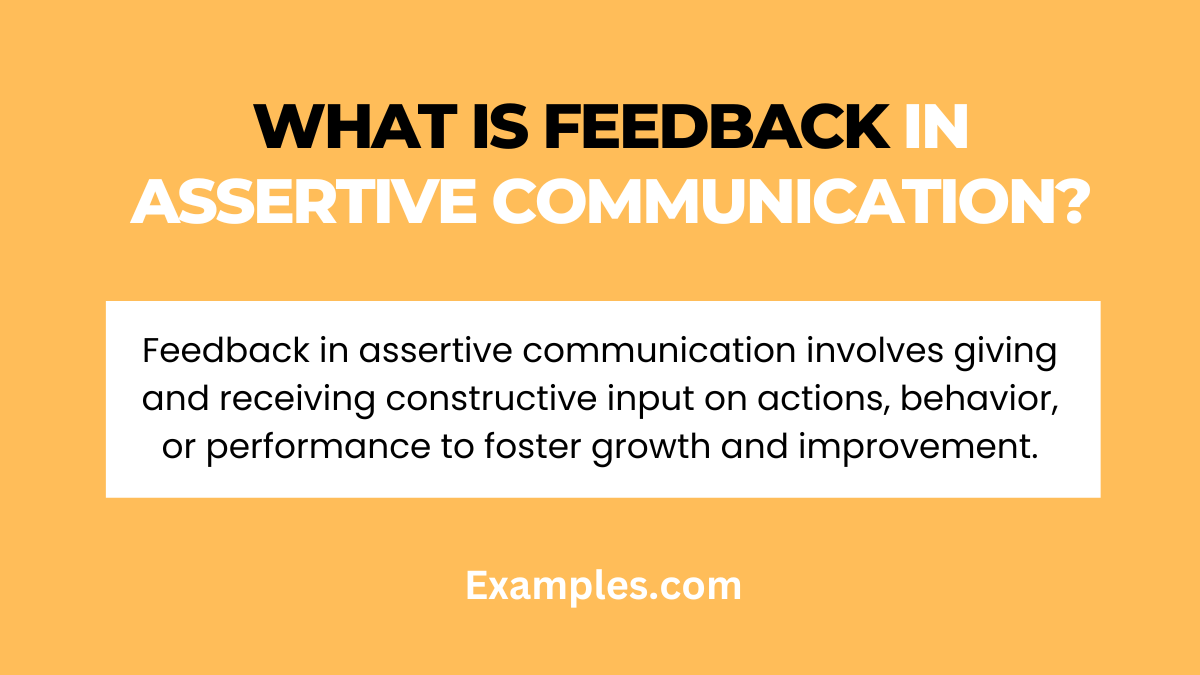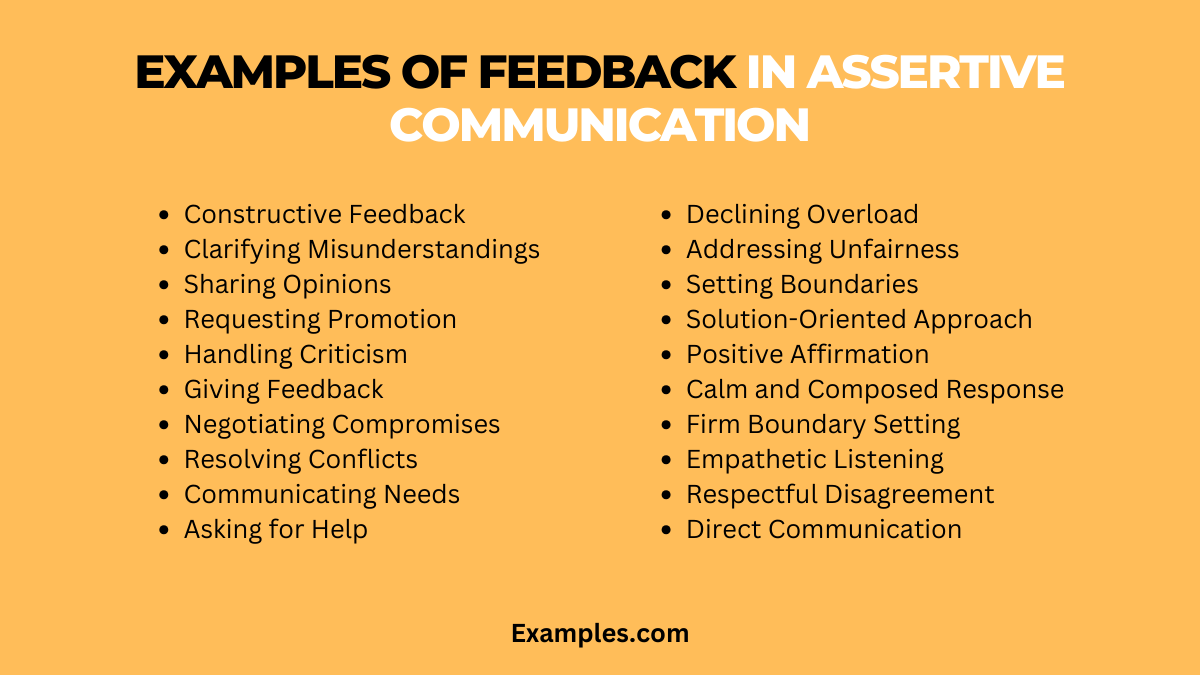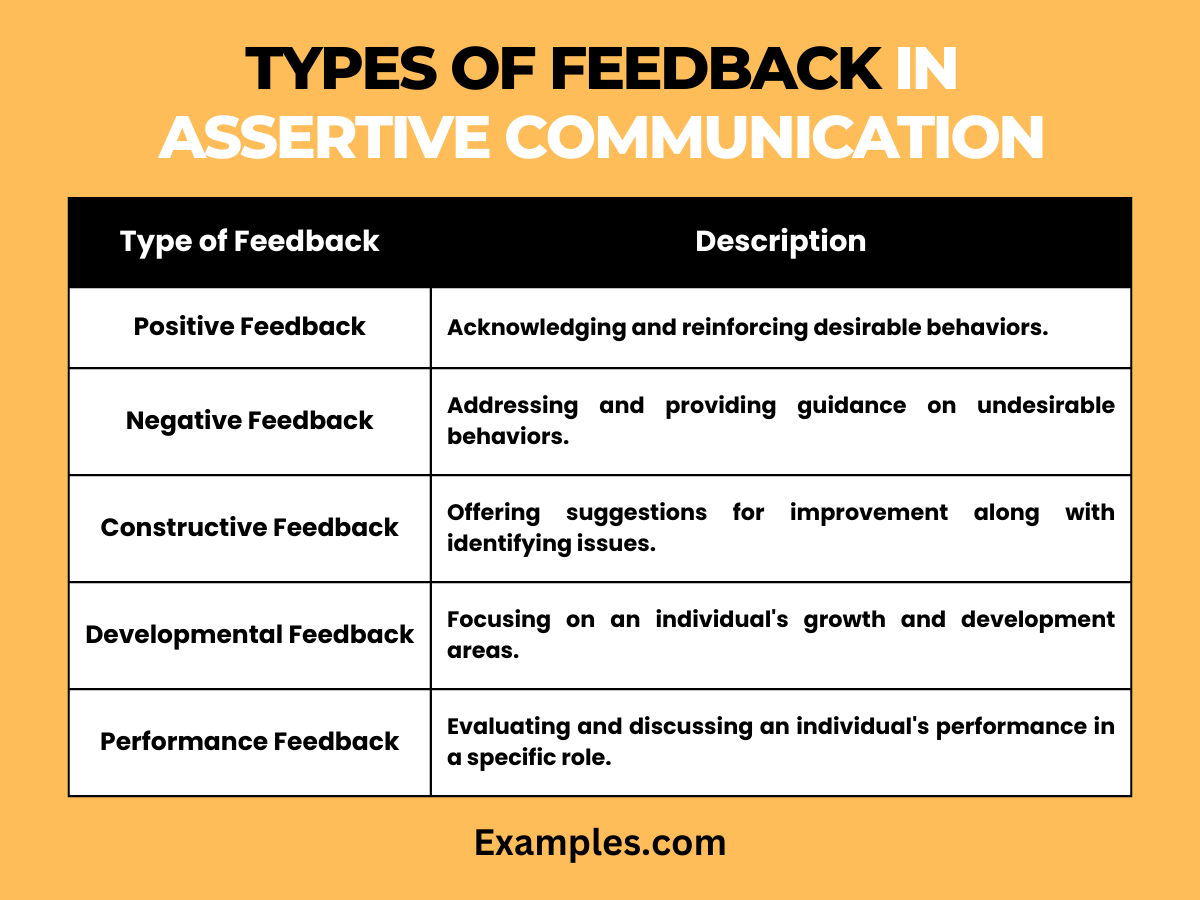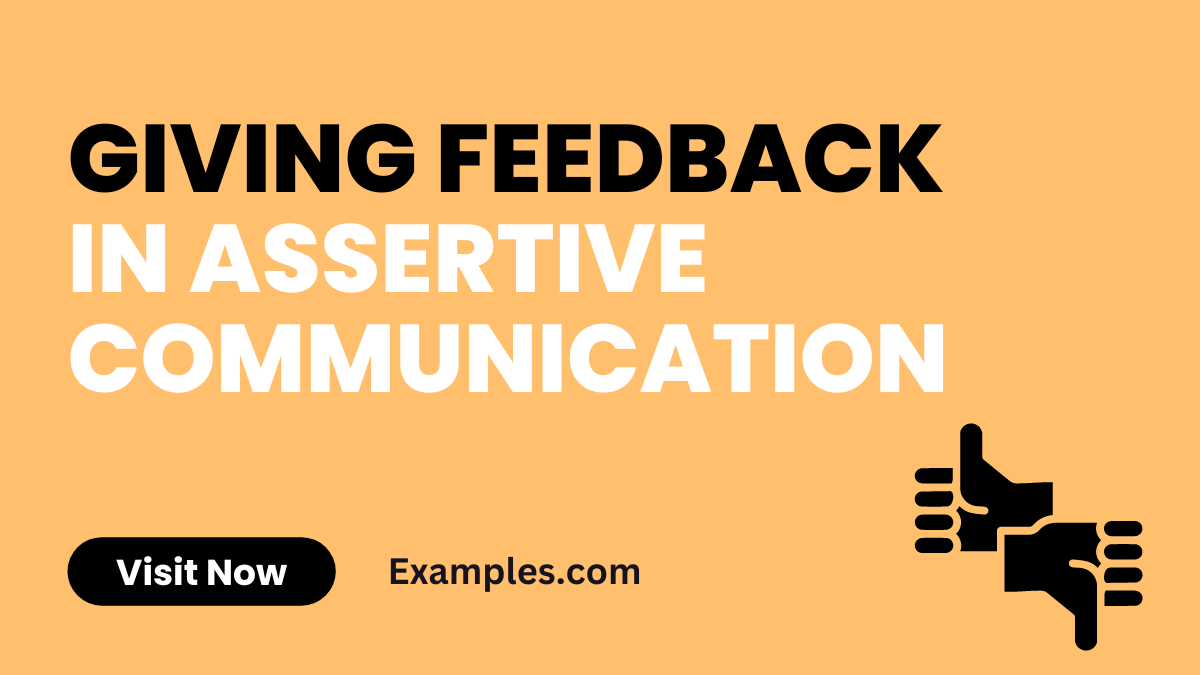19+ Giving Feedback in Assertive Communication Examples
In the world of assertive communication, the art of giving feedback is a pivotal skill. This guide will explore various aspects of giving feedback in assertive communication, providing valuable insights and techniques. From understanding the essence of assertive communication to mastering the skills, styles, and strategies, we’ll delve deep into this essential aspect. Get ready to unlock the power of assertive feedback for effective and respectful interactions.
What is Feedback in Assertive Communication?

Feedback in assertive communication serves as a valuable tool for conveying observations, thoughts, and feelings constructively. It promotes openness and mutual growth while enhancing the overall quality of communication. Keywords: Assertive Communication, Feedback.
20 Examples of Feedback in Assertive Communication

Giving Feedback in Assertive Communication is a crucial skill that involves providing constructive input while maintaining respect and open communication. It promotes growth and understanding in various situations.
1. Constructive Feedback: Offering specific, actionable advice to help someone improve their performance, fostering growth and development.
2. Clarifying Misunderstandings: Addressing any misconceptions or confusion to ensure both parties are on the same page, promoting clarity in communication.
3. Sharing Opinions: Expressing personal viewpoints and perspectives openly and respectfully to encourage dialogue and understanding.
4. Requesting Promotion: Assertively seeking recognition or advancement in a professional context, demonstrating confidence in one’s abilities.
5. Handling Criticism: Responding to negative feedback or criticism with composure and a focus on improvement, showcasing emotional control.
6. Giving Feedback in Assertive Communication: Providing constructive input while maintaining a respectful and open dialogue, promoting growth and understanding.
7. Negotiating Compromises: Engaging in discussions to reach mutually agreeable solutions, emphasizing a solution-oriented approach.
8. Resolving Conflicts: Addressing disagreements and disputes in a calm and composed manner to find resolutions effectively.
9. Communicating Needs: Expressing personal needs and desires assertively, ensuring they are acknowledged and met.
10. Asking for Help: Requesting assistance or support in a straightforward and confident manner, demonstrating self-awareness.
11. Declining Overload: Politely refusing additional tasks or responsibilities when one’s plate is already full, setting clear boundaries.
12. Addressing Unfairness: Confronting situations or behaviors that are perceived as unjust or biased, advocating for fairness.
13. Setting Boundaries: Establishing personal limits and expectations in interactions, maintaining self-respect and autonomy.
14. Solution-Oriented Approach: Focusing on finding practical and positive solutions to challenges or problems, promoting effective problem-solving.
15. Positive Affirmation: Offering encouragement and validation to others, fostering a positive and supportive environment.
16. Calm and Composed Response: Reacting to stressful or confrontational situations with poise and control, diffusing tension.
17. Firm Boundary Setting: Assertively defining the limits of acceptable behavior or expectations, maintaining personal integrity.
18. Empathetic Listening: Demonstrating understanding and empathy when others express their feelings or concerns, fostering connections.
19. Respectful Disagreement: Expressing differing viewpoints or opinions while maintaining respect for others’ perspectives.
20. Direct Communication: Clearly and straightforwardly conveying thoughts, needs, or feedback to ensure effective understanding and action.
How to Provide Feedback in Assertive Communication
- Active Listening: Before giving feedback, actively listen to the other person’s perspective to understand their point of view.
- Clear Expression: Express your feedback in a clear and concise manner, avoiding vague or ambiguous language.
- I Statements: Use “I” statements to express your feelings and thoughts, such as “I feel” or “I think,” to avoid sounding accusatory.
- Respectful Tone: Maintain a respectful and non-judgmental tone when providing feedback to avoid escalating conflicts.
- Empathy: Show empathy and understanding towards the other person’s feelings and thoughts while giving feedback.
- Body Language: Pay attention to your body language, ensuring it conveys openness and receptivity.
- Emotional Control: Keep your emotions in check and avoid getting defensive or aggressive during the feedback process.
- Constructive Feedback: Focus on providing constructive feedback that suggests solutions or improvements rather than solely pointing out problems.
Types of Feedback in Assertive Communication

| Type of Feedback | Description |
|---|---|
| Positive Feedback | Acknowledging and reinforcing desirable behaviors. |
| Negative Feedback | Addressing and providing guidance on undesirable behaviors. |
| Constructive Feedback | Offering suggestions for improvement along with identifying issues. |
| Developmental Feedback | Focusing on an individual’s growth and development areas. |
| Performance Feedback | Evaluating and discussing an individual’s performance in a specific role. |
Role of Giving Feedback in Assertive Communication
- Enhances Understanding: Feedback helps individuals understand how their actions or words impact others, fostering better communication.
- Promotes Growth: Constructive feedback supports personal and professional growth by identifying areas for improvement.
- Strengthens Relationships: Providing feedback assertively, while maintaining respect, can strengthen relationships by resolving conflicts and addressing concerns.
- Facilitates Change: Effective feedback serves as a catalyst for change, encouraging individuals to modify their behavior or approach.
- Builds Trust: Honest and respectful feedback builds trust among individuals, as it demonstrates a commitment to open communication.
- Encourages Self-Awareness: Receiving feedback encourages self-awareness, helping individuals gain insights into their strengths and weaknesses.
- Improves Decision-Making: Constructive feedback provides valuable input for decision-making and problem-solving.
- Empowers Individuals: Feedback empowers individuals to take ownership of their actions and make necessary adjustments for improvement.
In concluding our exploration of giving feedback within the realm of assertive communication, it is crucial to recognize the transformative power of this skill. Assertive feedback, when delivered effectively, not only fosters personal growth and understanding but also strengthens interpersonal relationships. It serves as a foundation for creating a respectful and constructive environment, be it in personal interactions or professional settings.
For further insights into effective communication strategies, particularly in professional contexts, visiting the Harvard Business Review can be enlightening. They offer a wealth of resources on communication techniques and leadership skills. Additionally, exploring MindTools, which provides extensive resources on personal and professional development, including communication skills, can be greatly beneficial. These platforms can offer valuable perspectives and tools to enhance your assertive communication capabilities, particularly in giving and receiving feedback.



